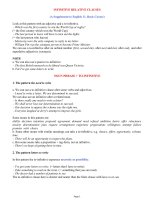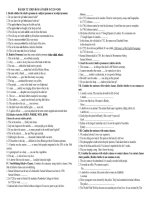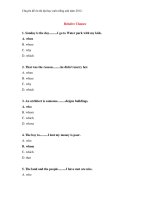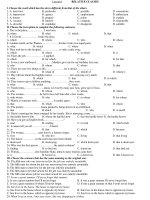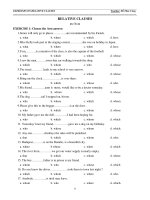relative clauses exercises
Bạn đang xem bản rút gọn của tài liệu. Xem và tải ngay bản đầy đủ của tài liệu tại đây (66.58 KB, 3 trang )
<span class='text_page_counter'>(1)</span><div class='page_container' data-page=1>
<b>RELATIVE CLAUSE EXERCISES</b>
Exercise 1: Choose the correct relative pronoun (who, which, whose).
1. This is the bank was robbed yesterday.
2. A boy sister is in my class was in the bank at that time.
3. The man robbed the bank had two pistols.
4. He wore a mask made him look like Mickey Mouse.
5. He came with a friend waited outside in the car.
6. The woman gave him the money was young.
7. The bag contained the money was yellow.
8. The people were in the bank were very frightened.
9. A man mobile was ringing did not know what to do.
10. A woman daughter was crying tried to calm her.
11. The car the bank robbers escaped in was orange.
12. The robber mask was obviously too big didn't drive.
13. The man drove the car was nervous.
14. He didn't wait at the traffic lights were red.
15. A police officer car was parked at the next corner stopped and arrested them.
Exercise 2: Use who for people; for everything else use which.
Decide whether to use who or which.
1. The people built Stonehenge lived several thousand years ago.
2. The huge stones are more than 6 metres high weigh about 45 tons.
3. The smaller stones weigh about 4 tons and are from an area in Wales is 400 kilometres
away from Stonehenge.
4. As Stonehenge lies in a large field, tourists come to this place can already see the
stones from a distance.
</div>
<span class='text_page_counter'>(2)</span><div class='page_container' data-page=2>
Exercise 3: Combine the sentences using relative clauses. Note that all relative clauses are
non-defining.
1. Samuel Johnson was the son of a bookseller. Samuel Johnson was born in 1709.
Samuel Johnson
2. In 1728, he went to Oxford. He studied at Pembroke College in Oxford.
In 1728, he went
3. Johnson had to leave Oxford without a degree. He was too poor to pay the fees.
Johnson
4. In 1737, Johnson moved to London. There he wrote poetry, essays and biographies.
In 1737, Johnson
5. In 1746, Johnson started to write his dictionary. It took him nine years to complete.
In 1746, Johnson started
6. His home at that time was in 17 Gough Square in London. It is a museum now.
17 Gough Square in London
7. In this house, his wife died in 1752. Her name was Elizabeth Porter.
In this house his wife
8. In 1755, the work was published. It was called A Dictionary of the English Language.
In 1755, the work
9. Samuel Johnson died in 1784. He is buried in Westminster Abbey.
Samuel Johnson
Exercise 4: Combine the sentences using a relative clause. Use relatvie pronouns only where
necessary. Note that you have to use commas in some of the sentences.
<b>A holiday in Scotland</b>
</div>
<span class='text_page_counter'>(3)</span><div class='page_container' data-page=3>
2. People live in Scotland. They are called Scots.
The people
3. We first went to Edinburgh. Edinburgh is the capital of Scotland.
We first
4. Arthur Conan Doyle was born in Edinburgh. He wrote the Sherlock Holmes stories.
Arthur Conan Doyle
5. Then we visited a lake. It is in the Highlands.
The lake
6. Loch Ness is 37 km long. People know it for its friendly monster.
Loch Ness
7. There we met an old man. He told us that he had seen Nessie.
An old man
8. We then travelled to a mountain. The mountain is near the town of Fort William.
We then
9. The mountain is the highest mountain in Great Britain. It is called Ben Nevis.
The mountain
</div>
<!--links-->

